Chapter 7 - The Cellular Basis of Inheritance
1/118
There's no tags or description
Looks like no tags are added yet.
Name | Mastery | Learn | Test | Matching | Spaced |
|---|
No study sessions yet.
119 Terms
What is sexual production?
The production of haploid cells and the fusion of a haploid cell from each genetic parent to form a single, unique diploid cell
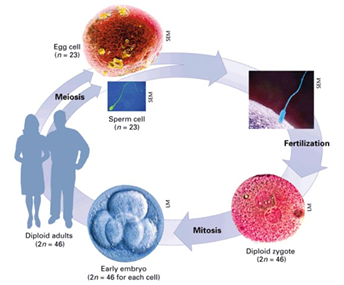
In multicellular organisms, what happens to the diploid cell formed by fertilization?
The new diploid cell undergoes mitotic cell divisions to develop into an adult organism
What is the type of cell division that leads to haploid cells in sexual reproduction?
Meiosis produces the haploid cells (gametes) that are part of the sexual reproductive cycle
How does sexual reproduction introduce variation into offspring?
Sexual reproduction, specifically meiosis and fertilization, introduces variation into offspring that may account for the evolutionary success of sexual reproduction
In genetics, what does the term “parent” mean?
“Parent” is used to describe the individual organism(s) that contribute genetic material to an offspring, usually in the form of gamete cells
What two processes alternate in sexual life cycles?
Fertilization and meiosis alternate in sexual life cycles
What happens during fertilization in the human life cycle?
In the human life cycle, a haploid (n) sperm fuses with a haploid (n) egg to create a diploid (2n) zygote in a process called fertilization
What is a zygote and what is its chromosome number?
The resulting fertilized egg is called a zygote, and it is diploid (2n) with two sets of chromosomes, one set from each parent
Why is meiosis important for maintaining chromosome number?
Producing haploid gametes by meiosis keeps the chromosome number from doubling in every generation
What are gametes?
Sex cells (egg and sperm)
From what type of cells are gametes produced?
Gametes are produced from diploid germ cells, a special cell line that only produces gametes
Can haploid gametes divide again once they are formed?
No. Once haploid gametes are formed, they lose the ability to divide again.
Is there a multicellular haploid life stage in humans?
No. There is no multicellular haploid life stage.
How is the diploid state restored during the human life cycle?
Fertilization occurs with the fusion of two gametes, usually from different individuals, restoring the diploid state
What is meiosis?
Meiosis is the nuclear division that forms haploid cells and employs many of the same mechanisms as mitosis
What is the purpose of Meiosis?
To start with a diploid (2n) germ cell and reduce the number of chromosomes to haploid (n) gametes.
Review: What does mitosis result in during the cell production cycle?
Results in genetically identical daughter nuclei that are identical to the original parent nucleus
Review: How many chromosome sets do the parent and daughter nuclei contain after mitosis?
In mitosis, both the parent and the daughter nuclei contain the same number of chromosome sets — diploid (2n) for most animals
How do the chromosome numbers differ between the starting nucleus and the resulting nuclei in meiosis?
In meiosis, the starting nucleus is always diploid (2n), and the nuclei that result at the end of meiotic cell division are haploid (n)
How many rounds of chromosome duplication and nuclear division occur in meiosis?
Meiosis consists of one round of chromosome duplication and two rounds of nuclear division
Why are mitotic stage names used in meiosis?
The events that occur during each division stage of meiosis are analogous to the events of mitosis, so the same stage names are assigned
How are the stages of meiosis designated?
There are two rounds of division
“I” (for the first division) or “II” (for the second division)
In Meiosis, how many times does interphase occur and how many cell divisions take place?
Interphase occurs once in meiosis, and there are two cell divisions: Meiosis I and Meiosis II.
What are two processes that occur in Meiosis that lead to genetic variation in gametes?
Crossing over (prophase I) and Independent Assortment (metaphase I).
What is Meiosis I?
Meiosis I is the first round of meiotic division and consists of stages such as prophase I, prometaphase I, metaphase I, anaphase I, and telophase I
What happens during Meiosis I?
Reduces the number of chromosome sets from two to one
Genetic information is also mixed during this division to create unique recombinant chromosomes
What is Meiosis II, and how does it compare to mitosis?
Meiosis II is the second round of meiotic division and occurs in a way that is similar to mitosis
It includes stages such as prophase II, prometaphase II, metaphase II, anaphase II, and telophase II
What happens before meiosis begins?
Meiosis is preceded by an interphase consisting of the G₁, S, and G₂ phases, which are nearly identical to the phases preceding mitosis
What occurs during the G₁ phase of interphase?
G₁ phase is the first phase of interphase and is focused on cell growth
What occurs during the S phase of interphase?
During the S phase, the DNA of the chromosomes is replicated
What occurs during the G₂ phase of interphase?
During the G₂ phase, the cell undergoes the final preparations for meiosis
What happens during Prophase I of meiosis I?
The nuclear envelope begins to break down
The proteins associated with homologous chromosomes bring the pair close to each other
Crossing over!
*Synapsis, Crossing Over, Chiasma, Recombinant sister chromatid, Tetrads
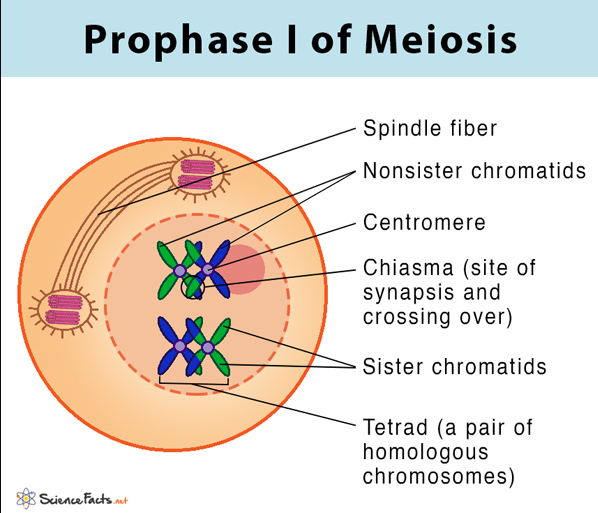
What special event occurs during Prophase I of Meiosis I?
Crossing over: Duplicated homologous chromosomes line up next to each other (synapsis) and exchange genetic material between non-sister chromatids (between paternal and maternal chromatids)
This generates recombinant chromosomes

What is synapsis?
The tight pairing of homologous chromosomes
The genes on the chromatids of homologous chromosomes are precisely aligned with each other
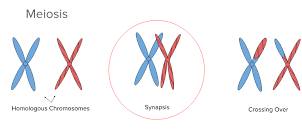
What is crossing over?
An exchange of chromosome segments between non-sister homologous chromatids

What is a chiasma?
Site of crossing over
The number of chiasmata varies with the species and the length of the chromosome
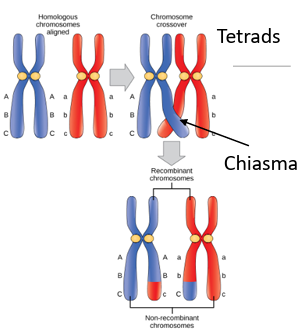
What is a recombinant sister chromatid?
Has a combination of maternal and paternal genes that did not exist before the crossover
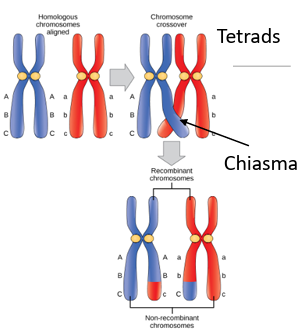
What are tetrads?
The four sister chromatids of each pair of homologous chromosomes
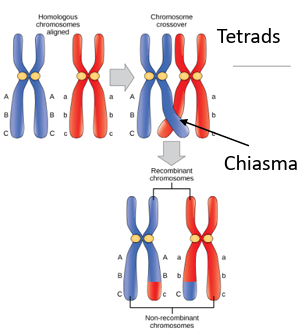
Why are crossover events significant?
Crossover events are the first source of genetic variation produced by meiosis
What happens during a single crossover event between homologous non-sister chromatids?
A single crossover event leads to a reciprocal exchange of equivalent DNA between a maternal chromosome and a paternal chromosome

What is the result of crossing over when a recombinant chromatid is moved into a gamete?
The recombinant chromatid will carry some DNA from one parent and some DNA from the other parent
What is Prometaphase I?
The phase in between Prophase I and Metaphase I where the chromosomes attach to the mitotic spindles
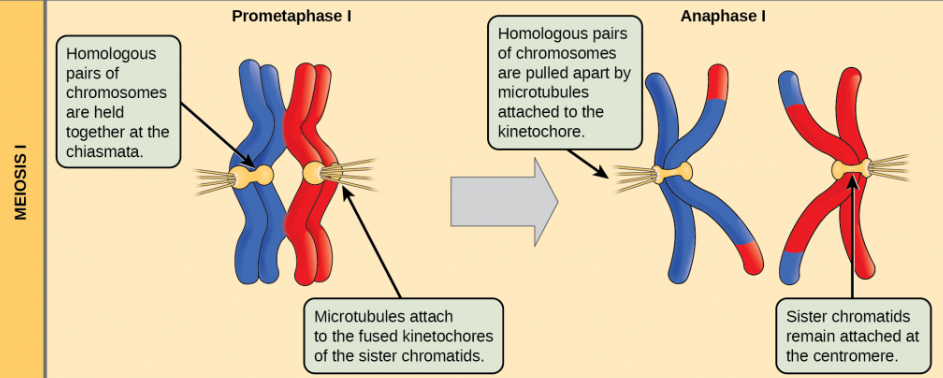
What is the key event of Prometaphase I in meiosis?
The attachment of the spindle fiber microtubules to the kinetochore proteins at the centromeres

What happens during Prometaphase I?
The mitotic spindle is assembled
Each tetrad is attached to microtubules from both poles, with one homologous chromosome attached to one pole and the other homologous chromosome attached to the opposite pole
The nuclear membrane has broken down entirely

What structure holds the homologous chromosomes together during Prometaphase I?
The homologous chromosomes are still held together at chiasmata
What is Metaphase I?
The phase following Prometaphase I
The homologous chromosomes are arranged in the center of the cell with the kinetochores facing opposite poles
*Independent assortment
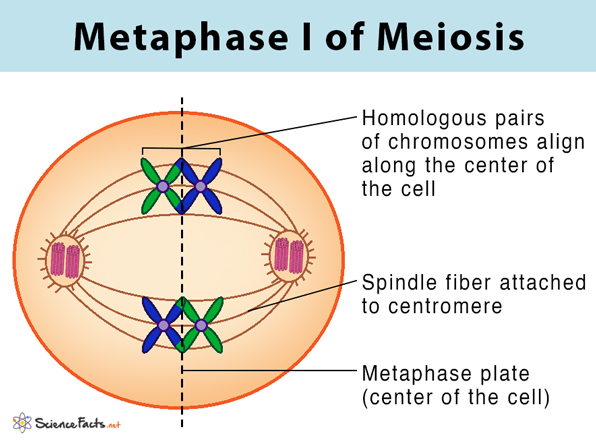
What special event occurs during Metaphase I of Meiosis I?
Independent assortment occurs: homologous chromosomes line up randomly next to each other
The paternal chromosomes can be on the left or right of the maternal chromosome in a chromosome set
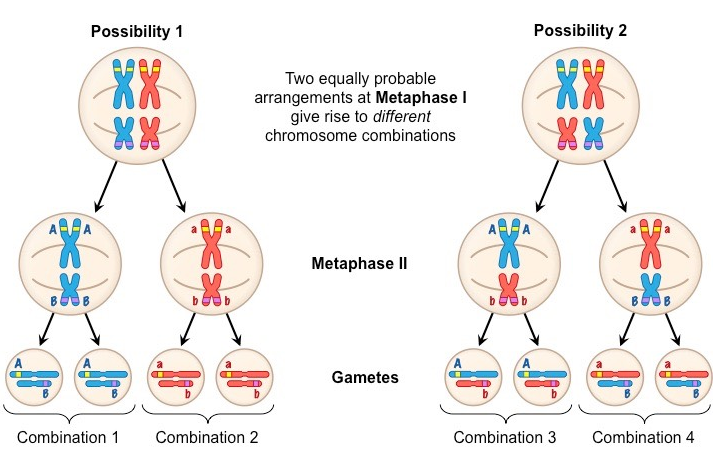
What is independent assortment and when does it occur?
Independent assortment is the random arrangement of tetrads at the metaphase plate during Metaphase I
What is the genetic significance of independent assortment?
It is the physical basis for generating the second form of genetic variation in offspring
How does independent assortment affect chromosome orientation?
Any maternally inherited chromosome may face either pole
Any paternally inherited chromosome may also face either pole
The orientation of each tetrad is independent of the orientation of the other 22 tetrads
Why is the arrangement of tetrads different in each meiosis event?
Because independent assortment is random, the arrangement of tetrads varies in every cell that undergoes meiosis
How is the number of possible chromosome alignments during Metaphase I calculated?
The number of possible alignments equals 2ⁿ, where n is the number of chromosomes per set
How many possible alignments exist for human chromosomes during Metaphase I?
Humans have 23 chromosome pairs, resulting in over 8 million (2²³) possible alignments
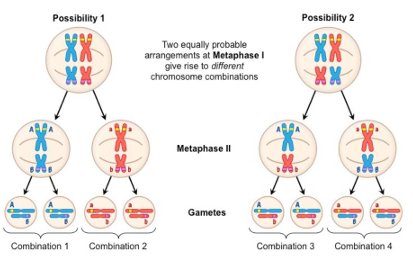
What additional factor increases genetic variation beyond independent assortment?
Crossover events previously created variability in the sister chromatids
Why is it highly unlikely that any two haploid cells from meiosis will be genetically identical?
Because independent assortment and crossover create immense genetic variability, making it highly unlikely that two haploid cells will have the same genetic composition
What is Anaphase I and what is happening during it?
Phase following Metaphase I
The spindle fibers pull the linked chromosomes apart, but the sister chromatids remain tightly bound together at the centromere
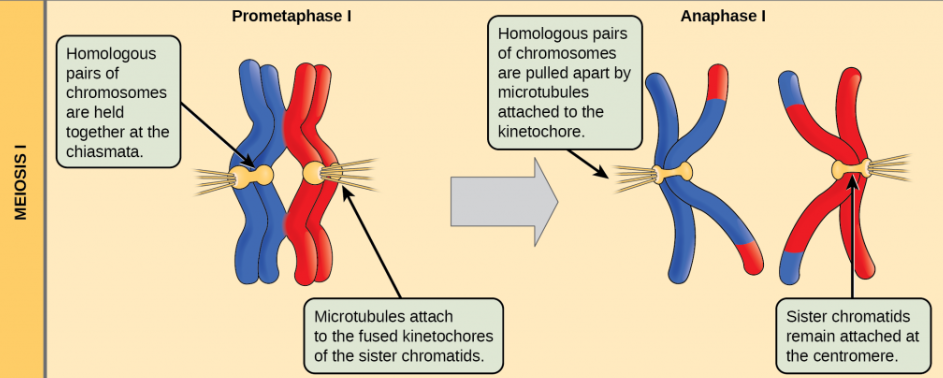
What specifically separates during Anaphase I?
The homologous chromosomes separate
The chiasma connections are broken in Anaphase I as the fibers attached to the fused kinetochores pull the homologous chromosomes apart

What happens during Telophase I?
The separated chromosomes arrive at opposite poles of the cell
The chromosomes decondense
Nuclear envelopes form around the chromatids
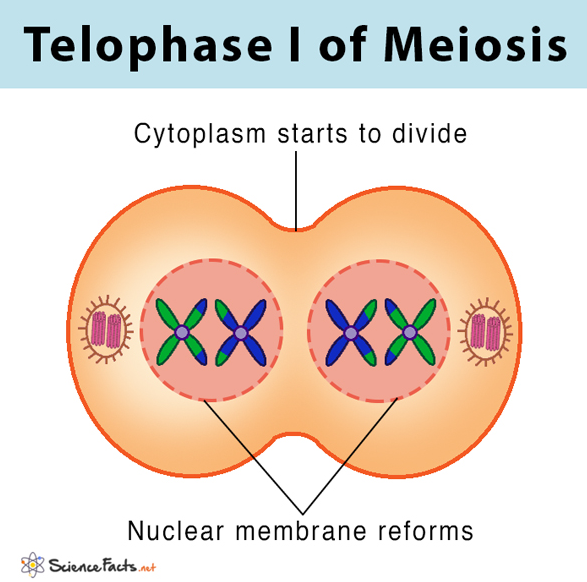
What is cytokinesis and when does it occur?
The physical separation of the cytoplasmic components into two daughter cells by cleavage furrow in animal cell
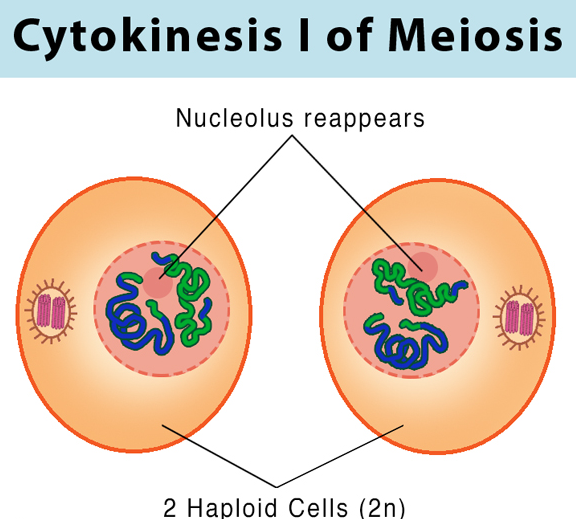
What is present at each pole after Telophase I and cytokinesis?
At each pole, there is just one member of each pair of homologous chromosomes — only one full set of chromosomes is present
Why are the cells considered haploid after meiosis I?
They are considered haploid because there is only one chromosome set in each daughter cell
What happens to the two cells produced in meiosis I before meiosis II begins?
The two cells produced in meiosis I go through the events of meiosis II in synchrony
Overall, meiosis II resembles the mitotic division of a haploid cell
What is produced at the end of Meiosis I?
Two haploid daughter cells are produced
Since homologous chromosomes separated in anaphase I, each daughter cell has one chromosome set (even though they are duplicated)
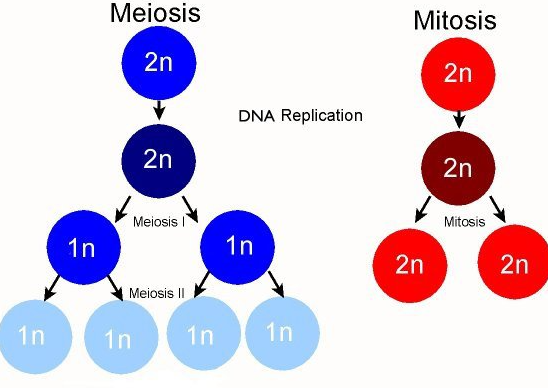
What occurs during Prophase II?
Since the chromosomes decondensed in telophase I, they condense again
Nuclear envelopes fragment again
New mitotic spindles are formed
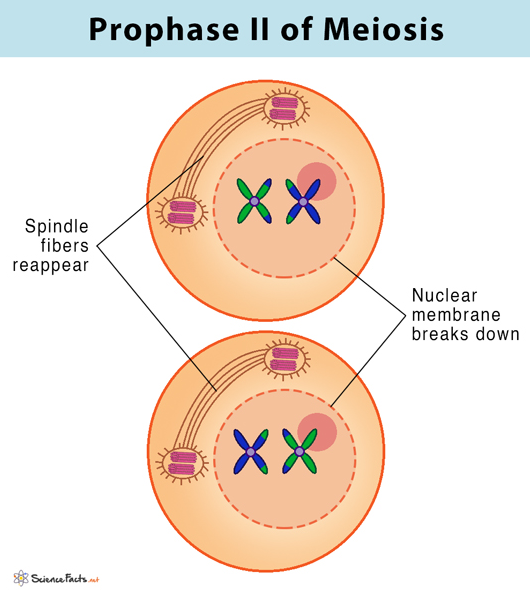
What happens in Prometaphase II?
The nuclear envelopes are completely broken down
The mitotic spindle is fully formed
Each sister chromatid forms an individual kinetochore that attaches to microtubules from opposite poles
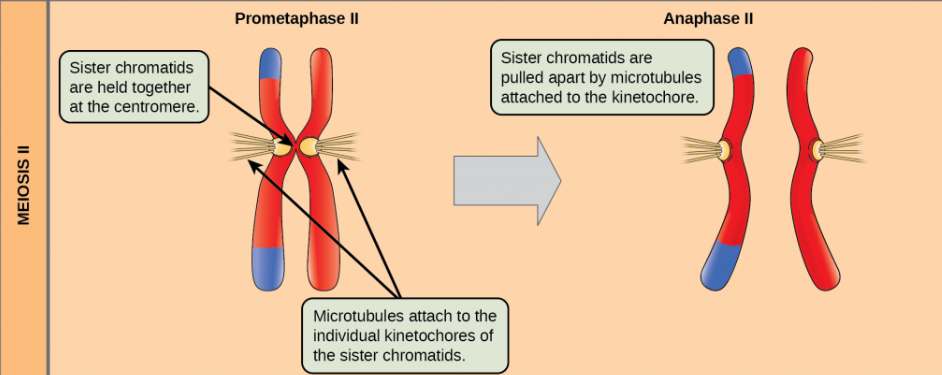
What occurs during Metaphase II?
The sister chromatids are maximally condensed and aligned at the center of the cell (the metaphase plate
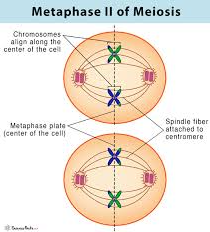
What happens during Anaphase II?
Sister chromatids are pulled apart by the spindle fibers and move toward opposite poles of the cel
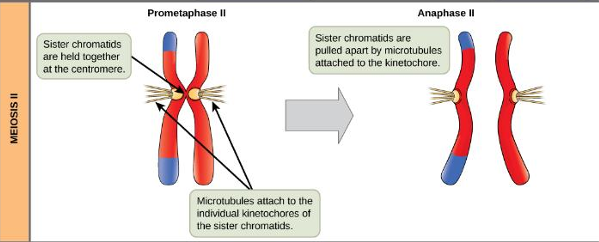
How does Anaphase I differ from Anaphase II in Meiosis?
In Anaphase I, homologous chromosomes separate from each other
In Anaphase II, sister chromatids of duplicated chromosomes separate from each other
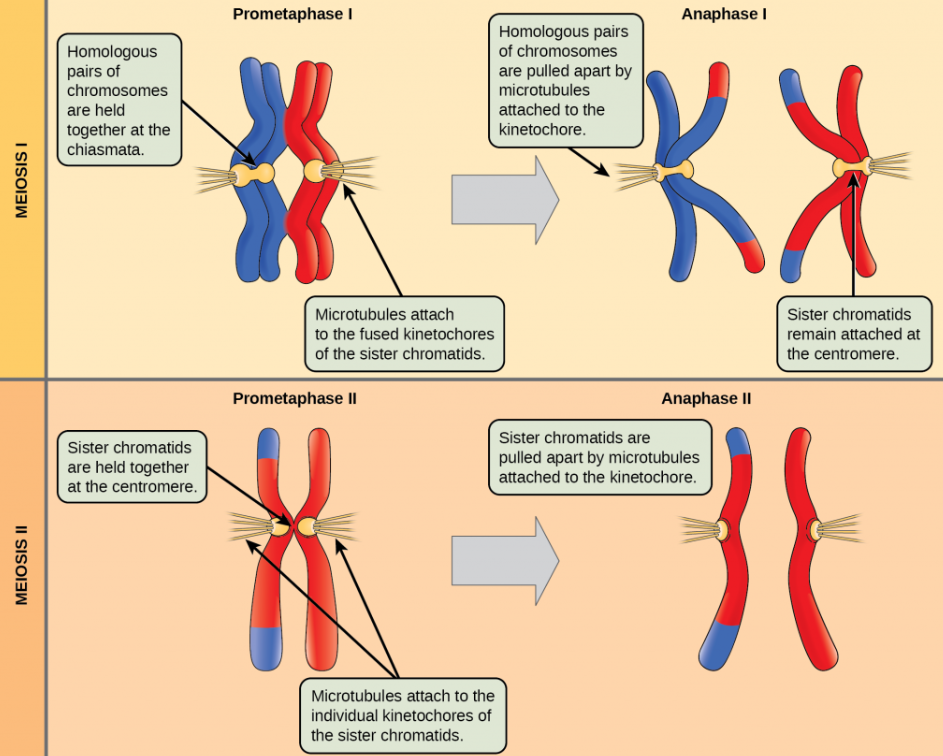
What occurs during Telophase II?
The chromosomes arrive at opposite poles and begin to decondense
Nuclear envelopes form around the chromosomes
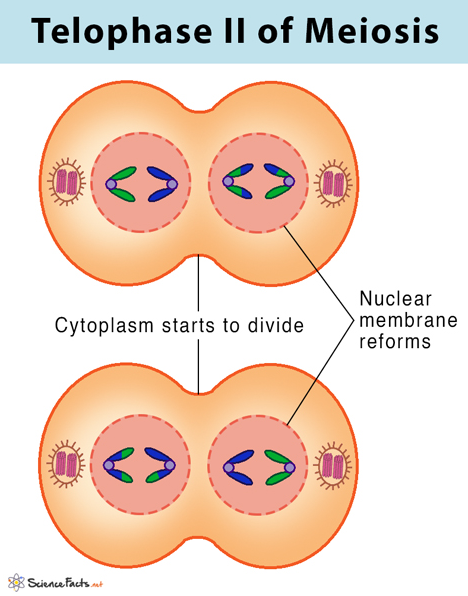
What happens during Cytokinesis at the end of meiosis II?
Separates the two cells into four genetically unique haploid cells
The nuclei in the newly produced cells are both haploid and have only one copy of the single set of chromosomes
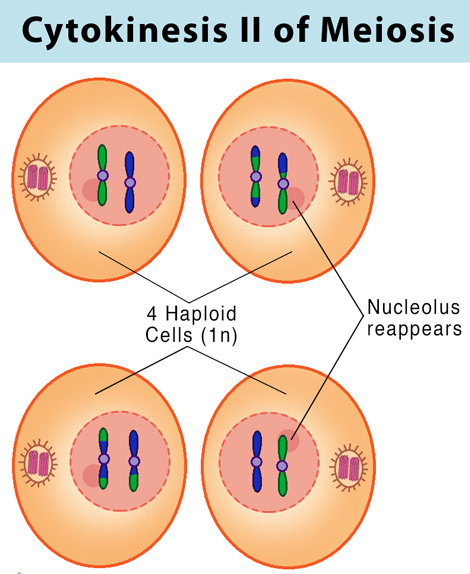
What is produced at the end of Meiosis II?
At the end of Meiosis II, four haploid genetically unique gamete cells are made
The cells no longer divide after Meiosis II
These gametes (egg or sperm) will only be used for fertilization and creation of a zygote

Why are the cells produced by meiosis II genetically unique?
The random assortment of paternal and maternal homologs and the recombination of maternal and paternal segments of chromosomes—with their sets of genes—that occurs during crossover
An organism has been identified with a diploid number of chromosomes to be 24 (2n = 24). At the end of mitosis, how many chromosomes do you expect to find in each daughter cell? At the end of meiosis, how many chromosomes do you expect to find in each daughter cell?
At the end of mitosis, there will be 24 chromosomes in each daughter cell. At the end of meiosis, there will be 12 chromosomes in each daughter cell.
Review Meiosis
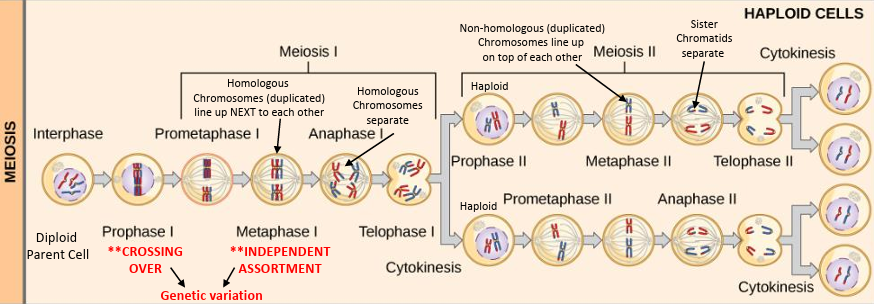
4 genetically unique haploid (n) daughter cells = gametes
Review Mitosis

2 genetically identical diploid (2n) daughter cells = somatic cells
Review the difference in Chromosome Number between Mitosis and Meiosis
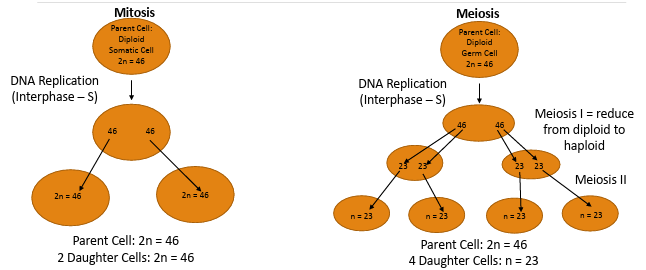
How can inherited disorders arise during meiosis?
Inherited disorders can arise when chromosomes behave abnormally during meiosis.
What are the two main categories of chromosome disorders?
Abnormalities in chromosome number
Chromosome structural rearrangements
Why are chromosomal disorders often dramatic and fatal?
Because even small segments of chromosomes can span many genes, so changes in structure or number usually have severe effects.
What is a karyotype?
A karyotype is the number and appearance of chromosomes, including their length, banding pattern, and centromere position
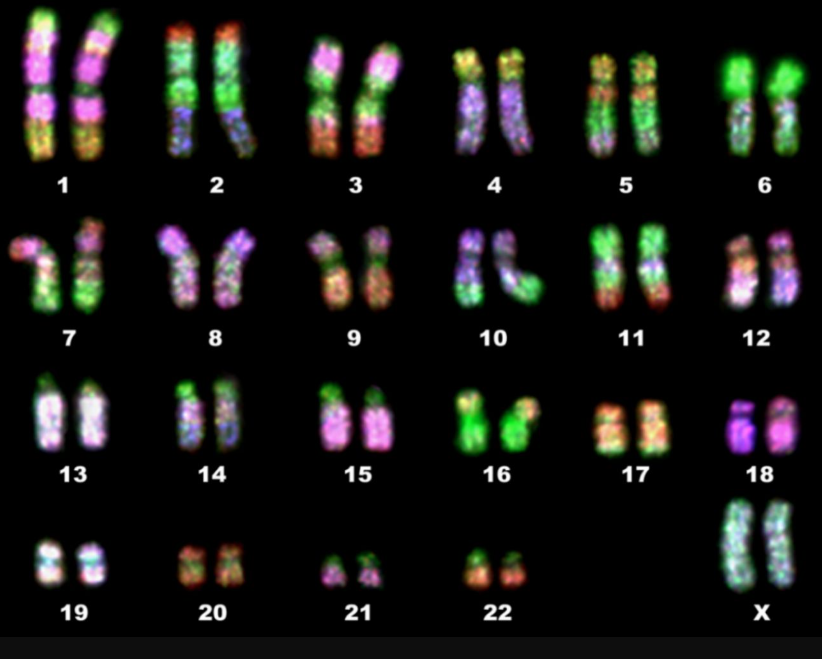
How do cytologists obtain a view of an individual’s karyotype?
They photograph the chromosomes and then cut and paste each chromosome into a chart called a karyogram
What is the basis of cytogenetics and the primary method for detecting chromosomal abnormalities in humans?
The isolation and microscopic observation of chromosomes
What do disorders of chromosome number include?
The duplication or loss of entire chromosomes
Changes in the number of complete sets of chromosomes
What is nondisjunction?
Occurs when pairs of homologous chromosomes or sister chromatids fail to separate properly during meiosis
Can happen in either Meiosis I or Meiosis II
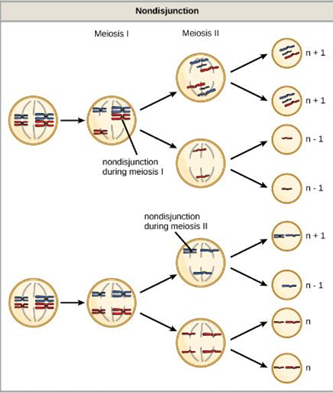
What phases of Meiosis can nondisjunction occur?
Can occur during either meiosis I or II, with different results
What is the result of nondisjunction?
Causes duplications or loss of chromosomes in gametes
Change in chromosome number in gametes
The risk of nondisjunction increases with the age of the parents
What happens if homologous chromosomes fail to separate during meiosis I?
The result is
Two gametes that lack that chromosome
Two gametes with two copies of the chromosome
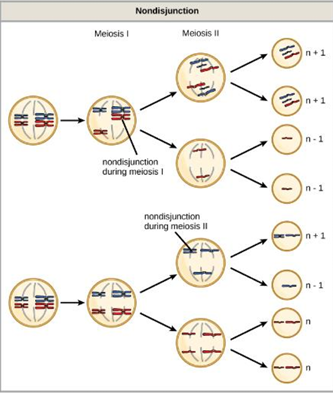
What happens if sister chromatids fail to separate during meiosis II?
The result is
One gamete that lacks that chromosome
Two normal gametes with one copy of the chromosome
One gamete with two copies of the chromosome
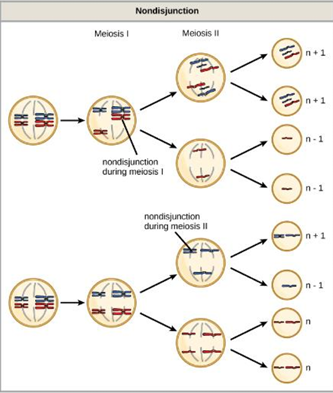
What does “euploid” mean?
An individual with the appropriate number of chromosomes for their species
In humans, euploidy corresponds to 22 pairs of autosomes and 1 pair of sex chromosomes
Autosomes = non-sex chromosomes
What does “aneuploid” mean?
An individual with an error in chromosome number
What is monosomy?
The loss of one chromosome
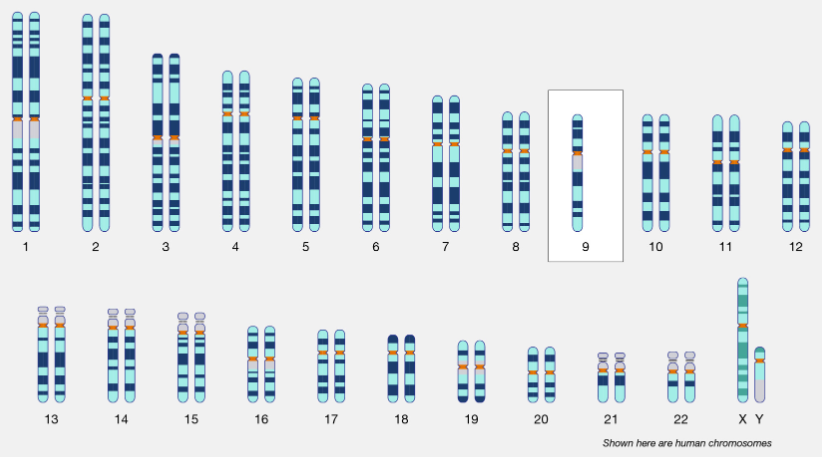
What is trisomy?
The gain of an extra chromosome
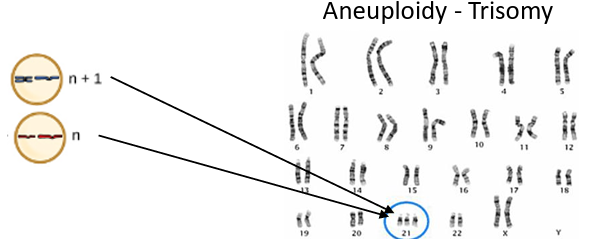
What happens to monosomic human zygotes missing one copy of an autosome?
They invariably fail to develop to birth because they have only one copy of essential genes
What happens to most autosomal trisomies?
Most fail to develop to birth; however, duplications of some of the smaller chromosomes (13, 15, 18, 21, or 22) can result in offspring that survive for several weeks to many years
What type of genetic imbalance do trisomic individuals experience?
An excess in gene dose.
Cell functions are calibrated to the amount of gene product produced by two copies (doses) of each gene.
Adding a third copy (dose) disrupts this balance.
What is the most common trisomy and what does it cause?
The most common trisomy is trisomy 21, which leads to Down syndrome
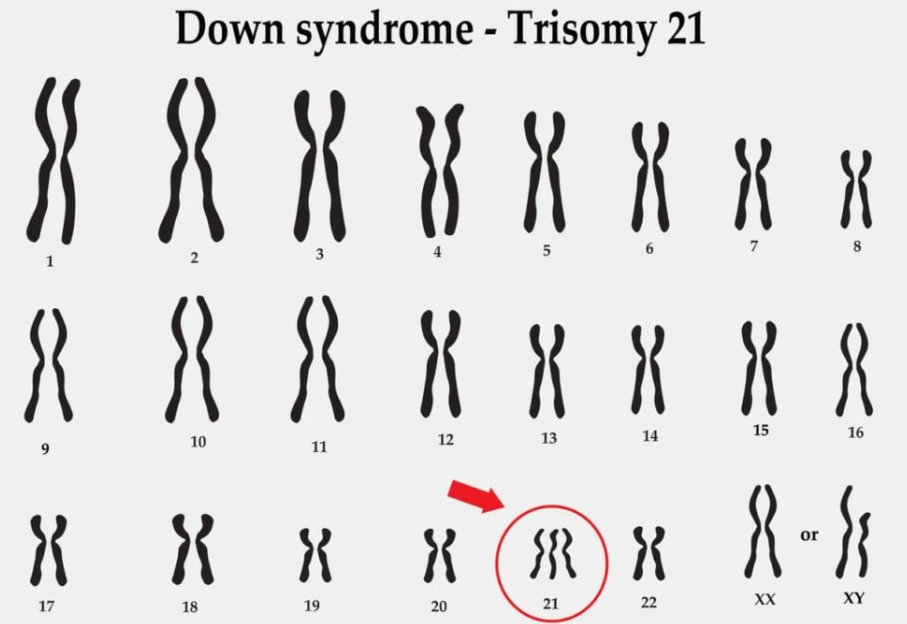
What are the characteristics of individuals with Down syndrome?
They have characteristic physical features and developmental delays in growth and cognition.
What factor increases the incidence of Down syndrome?
Maternal age — older women are more likely to give birth to children with Down syndrome
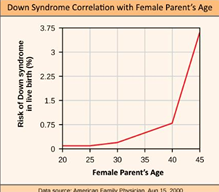
What is X inactivation in female mammals?
Since females have two X chromosomes (XX) > Early in embryonic development, one X chromosome in each cell randomly inactivates by condensing into a structure called a Barr body
What happens to genes on the inactive X chromosome?
The genes on the inactive X chromosome are not expressed